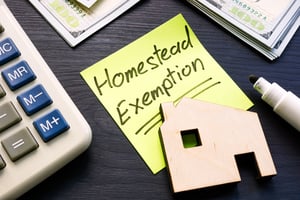 When a person files for chapter 7 bankruptcy, they are allowed to claim certain property as “exempt,” or legally protected from creditors up to a certain value. Property that is exempt cannot be taken by the chapter 7 trustee to be used to pay the debtor’s creditors, whereas “nonexempt” property can be taken for that purpose. Minnesota allows debtors to elect either “State exemptions” or “Federal exemptions” to exempt, and protect, their property. The Federal exemptions are those specifically provided in the Federal Bankruptcy Code. State exemptions include any Minnesota State law, or applicable Federal law, not provided for in the Bankruptcy Code. Deciding whether to use State or Federal exemptions is complicated and better elaborated upon in other blogs. However, it is imperative that the debtor select the correct exemptions to use, as it often drastically impacts how much property they will be able to exempt. This is why it is also a good idea to discuss one’s potential bankruptcy case with an experienced bankruptcy attorney before filing one’s bankruptcy case.
When a person files for chapter 7 bankruptcy, they are allowed to claim certain property as “exempt,” or legally protected from creditors up to a certain value. Property that is exempt cannot be taken by the chapter 7 trustee to be used to pay the debtor’s creditors, whereas “nonexempt” property can be taken for that purpose. Minnesota allows debtors to elect either “State exemptions” or “Federal exemptions” to exempt, and protect, their property. The Federal exemptions are those specifically provided in the Federal Bankruptcy Code. State exemptions include any Minnesota State law, or applicable Federal law, not provided for in the Bankruptcy Code. Deciding whether to use State or Federal exemptions is complicated and better elaborated upon in other blogs. However, it is imperative that the debtor select the correct exemptions to use, as it often drastically impacts how much property they will be able to exempt. This is why it is also a good idea to discuss one’s potential bankruptcy case with an experienced bankruptcy attorney before filing one’s bankruptcy case.
Just because a debtor simply claims that their property is exempt in their bankruptcy petition, doesn’t automatically mean the property is exempt. Any party with a legal interest in the case may file an objection to any property that the debtor claims is exempt. This could be one of the debtor’s creditors, but typically, it is the trustee themselves that objects to the debtor’s claimed exemptions. However, there are certain timelines for interested parties to object to the debtor’s exemptions. Generally, if none of the interested parties object to the debtor’s claimed objections within the allowed time period, the claimed objection becomes legally valid and can no longer be challenged by any interested party.
So, when is this deadline to file an objection to any of the debtor’s claimed exemptions? The trustee will conduct a creditor’s meeting (aka a “341 meeting”) approximately one month after the debtor files their bankruptcy case. At this meeting both the trustee and creditors can examine the debtor, or ask the debtor questions, under oath, which are relevant to the debtor’s bankruptcy case. The deadline to file an objection to the debtor’s claimed exemptions is 30 days after the creditor’s meeting has “concluded.” A creditor’s meeting is concluded by the trustee when the trustee determines that all interested parties have had the opportunity to examine the debtor and that no further meetings are needed. Creditor’s meetings are usually promptly concluded after the first meeting, but can be left open, particularly in cases where the trustee believes more relevant information is needed from the debtor’s testimony.
However, there are exceptions to the rule that interested parties must file an objection to the debtor’s claimed exemptions within the 30 day time period from the conclusion of the creditor’s meeting. One such exception is if the court grants an interested party additional time to file an objection if the court thinks it fair to allow more time to do so. For an interested party to be allowed additional time to file an objection to any of the debtor’s claimed exemptions, they must file a formal written motion asking the court to grant more time and the motion must be filed before the expiration of the 30 day time period from the conclusion of the creditor’s meeting. Another exception is that an interested party may object to any of the debtor’s claimed exemptions within one year after the debtor’s bankruptcy case is closed upon a showing that the debtor’s exemption claim was based on fraud.
Other exceptions apply in which a bankruptcy case is converted from one type of bankruptcy to another or when the debtor files an amended petition, in which they amend their claimed exemptions. For example, debtors sometimes convert their case from a chapter 13 repayment plan to a chapter 7 case for a number of reasons, such as a sudden drop in income that leaves them unable to make payments. When a case is converted from a chapter 13 to a chapter 7, an interested party has 30 days from the conclusion of the chapter 7 creditor’s meeting to object to the debtor’s claimed exemptions, just as if the debtor had filed a chapter 7 from the beginning. This is unless the debtor’s case is converted to a chapter 7 more than a year after the debtor originally filed their chapter 13 case. In this case, if no objection was filed within the 30 day time period from the date of the chapter 13 creditor’s meeting, no interested party may object to the claimed exemptions in the chapter 7 case. Also, if a debtor amends their claimed exemptions during their bankruptcy case, the deadline for interested parties to file an objection to claimed exemptions is extended. Once the amended petition is filed with the court, interested parties then have 30 additional days from the date the petition is filed to file an objection.
CALL NOW FOR A FREE STRATEGY SESSION FROM A MN BANKRUPTCY LAWYER AT LIFEBACK LAW FIRM
This is a generalized overview of a debtor’s right to claim property as exempt and the creditor’s/trustee’s rights to object to those exemption claims. It is always advisable to discuss your specific circumstances with an experienced bankruptcy attorney before filing a case to ensure your rights and property are protected to the greatest extent possible if you do file a bankruptcy case. See us at LifeBackLaw.com!


